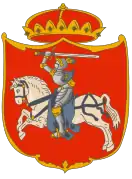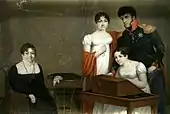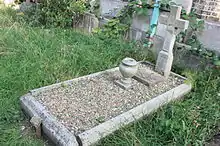House of Golitsyn
The Golitsyn family originated in the Grand Duchy of Lithuania and became one of the largest princely of the noble houses of Russia. The Russian: Голи́цын, tr. Golitsyn, IPA: [ɡɐˈlʲitsɨn] is alternatively transliterated: Galitzine, Galitzin, Galitsyn, Galitsin, Galizyn, Golitzin, Golizyn or Golitsin.
| Golitsyn Голицын | |
|---|---|
 | |
| Parent house | House of Gediminas |
| Country | Grand Duchy of Moscow Tsardom of Russia Imperial Russia |
| Founded | 15th century |
| Founder | Mikhail Bulgark-Golitsa |
| Titles | Prince and Princess |
| Cadet branches | Kurakins, Khovansky, Koretsky |
Origins
The family descends from a Lithuanian prince George, son of Patrikas and grandson of Narimantas, thus great-grandson of Gediminas (d. 1341), Grand Duke of Lithuania. Other descendants of Patrikas are the Houses of Kurakin and Khovanski, other Gediminids (descendants of Gediminas) were the royal Jagiellonian dynasty of Polish-Lithuanian Commonwealth (a cadet branch of Gediminids) and a number of princely families of the Commonwealth (Czartoryski, Sanguszko, Koriatowicz-Kurcewicz e.a.) and Russia (Bulgakov, Trubetskoy, Mstislavsky, Belsky and Volynsky). After the extinction of the Korecki family in the 17th century, the Golitsyns claimed dynastic seniority in the House of Gediminas.
History

George immigrated to the court of Vasily I of Moscow and married Vasily's sister. His children and grandchildren, among them Vassian Patrikeyev, were considered premier Russian boyars. One of them, Prince Mikhail Bulgark (The Bulgarian), earned the nickname Golitsa (glove, geležìs in Old Lithuanian) for an iron (or strong leather) glove he wore in the Battle of Orsha in 1514. His son Yuri Bulgark-Golytsin continued with the family line and his great-grandson Prince Vasily Golitsyn (d. 1619) was active during the Time of Troubles and went as an ambassador to Poland to offer the Russian crown to Prince Władysław.[1]
All living members of the House of Golitsyn are also descendants of Ivan III of Russia (the Great) and his second wife Sophia Palaiologina[2] through their daughter Eudoxia Ivanovna (1492–1513) who married Peter (born Kudaikul), son of Ibrahim, Khan of Kazan, whose daughter Anastasia Petrova married Fyodor Mstislavsky.
The family produced many well-known statesmen and generals, among them Vasily Vasilyevich Golitsyn (1643–1714), Boris Alexeyevich Golitsyn (1654-1714) Dmitry Mikhaylovich Golitsyn (1665–1737) and Nikolai Golitsyn (1850–1925), the last prime-minister of Imperial Russia who was executed by the Bolsheviks.
Of the numerous branches of the princely family that existed in 1917, only one survived in the Soviet Union; all others were extinguished or forced into exile. The Bolsheviks arrested dozens of Golitsyns only to be shot or killed in the gulag; dozens disappeared in the storm of the revolution and the Russian Civil War, and their fate remained unknown.[3] Today more Golitsyns live in the US than in Russia. Sergei Golitsyn (1909–1989) published his Memoirs of a Survivor: The Golitsyn Family in Stalin's Russia, covering the period from the revolution in 1917 to the entry of the Soviet Union into World War II in 1941.
Notable Golitsyns


- Vasily Vasilyevich Galitzin (1643–1714) was one of the Greatest Russian statesmen of the 17th century, principal minister of state during the Regency of Sophia Alekseyevna (1682–1689)
- Boris Alexeyevich Galitzin (1654–1714), was a cousin and the chief political opponent of Vasily Vasilyevich and thereafter influential minister of Peter the Great.
- Dmitry Mikhailovich Galitzin (1665–1737), another cousin of Vasily Vasilyevich, was noted for his attempt to turn Russia into a constitutional monarchy.
- Mikhail Mikhailovich Galitzin (c. 1674–1730), Dmitry's brother, was a field marshal and is best known for his governorship of Finland (1714–1721), where his harsh rule is remembered by the people he had conquered as the Greater Wrath (Swedish: Stora ofreden).
- Mikhail Mikhailovich Golitsyn (1684–1764), Dmitry's younger brother, was general admiral of the Russian fleet (1756).
- Mikhail Alekseevich Golitsyn (1687–1775), a grandson of Vasily Vasilyevich, was punished by Empress Anna of Russia for converting to Catholicism and marrying a Catholic Italian woman in being forced to become a court jester. His wedding to another court jester inside Anna Ivanovna's palace remained famous.
- Alexander Mikhailovich Golitsyn (1718–1783), Mikhail Mikhailovich's son, was a diplomat and soldier, who likewise rose to be field-marshal and governor of St. Petersburg.
- Dmitry Mikhailovich Golitsyn (1721–1793), another of Mikhail Mikhailovich's son, was the Russian ambassador in Vienna during the reign of Catherine the Great. Primarily remembered for the splendid Golitsyn Hospital he opened in Moscow, he should also be noted as a great friend and patron of Mozart.
- Alexander Mikhailovich Golitsyn (1723–1804), son of general admiral Mikhail Mikhaylovich Golitsyn
- Prince Dmitry Alekseyevich Golitsyn (1738–1803) was the Russian ambassador to the Netherlands and a Fellow of the Royal Society.
- Prince Dmitry Dmitriyevich Golitsyn (1770–1840), a son of Dmitry Alekseyevich, also known as the Apostle of the Alleghenies, was the first Roman Catholic priest ordained in America; a settlement in Pennsylvania is named after him. He is currently under investigation for possible Sainthood, his current title is Servant of God.
- Prince Dmitri Vladimirovich Golitsyn (1771–1844) fought bravely during the Napoleonic wars, was promoted to the rank of Lieutenant General and governed Moscow for 25 years.
- Prince Alexander Nikolayevich Golitsyn (1773–1844) was a reactionary minister of education in the government of Alexander I. He headed an investigation into masonic involvement in the Decembrist uprising of 1825 and served as the Chairman of the State Council from 1838 to 1841.
- Prince Nikolay Borisovich Galitzin (1794–1866) was an amateur cellist who commissioned Beethoven to write his last string quartets, sometimes called the Galitzin quartets.
- Princess Yelizaveta Alexeyevna Golitsyna (1797–1844) Roman Catholic nun.
- Prince Alexei Vasilyevich Golitsyn (1832–1901) was a friend of Pyotr Ilyich Tchaikovsky. Like the composer, Golitsyn was homosexual; but unlike the composer, he lived openly with his lover, Nikolay Vasilyevich Masalitinov (d. 1884).[4]
- Prince Grigory Sergeyevich Golitsin (1838–1907) was a general and the Governor of Transcaucasia in 1897–1904.
- Prince Lev Sergeyevich 24 June [O.S. 12 June] 1845–8 January 1916 [O.S. 26 December 1915] was one of the founders of winemaking in the Crimea. In his Crimean estate of Novyi Svet he built the first Russian factory of champagne wines. In 1889 the production of this winery won the Gold Medal at the Paris exhibition in the nomination for sparkling wines. He became the surveyor of imperial vineyards at Abrau-Dyurso in 1891.
- Prince Nikolai Dmitriyevich Golitsyn (1850–1925) was the last Tsarist prime minister of Russia, at the time of the February Revolution.
- Princess Sophie Galitzine (1858–1883) who married French aristocrat Paul d'Albert de Luynes, Duke of Chaulnes and Picquigny and was the mother of Emmanuel d'Albert de Luynes, Duke of Chaulnes and Picquigny and Marie Thérèse, Duchess of Uzès.
- Prince Boris Borisovich (1862–1916) was a prominent physicist who invented the first electromagnetic seismograph in 1906.
- Prince Vladimir Golitsyn (1902–1943) After an early career as a sailor, during the 1920's Vladimir began a very successful career as a book illustrator and well-known artist, illustrating around forty books between 1925-1941. He also worked for the magazines the Universal Pathfinder, Pioneer and several others. Despite his very popular artwork, he was barely tolerated by the Stalinist bureaucracy and as general conditions worsened, found it increasingly hard to support his parents and young family. According to his brother, the writer Sergei Golitsyn, Vladimir died from exhaustion and under-nourishment in the Sviyazhska prison camp on 6 February 1943.
- Prince Leo Golitsyn (b. 1905), who escaped from Soviet Russia during World War I and came to settle in Canada by 1929 in Edson, Alberta. He and his wife, an Egyptian Princess, purchased 420 acres of land, mostly bordering the McLeod River.[5] Golitsyn and his wife started an airplane charter company at Bear Lake. After the Princess died during a vacation in Europe, Leo moved to Hollywood where he was seen acting in various films as an extra, including in the The Razor's Edge and The Chocolate Soldier.[6]
- Sergei Golitsyn (1909–1989), who wrote Memoirs of a Survivor: The Golitsyn Family in Stalin's Russia, a memoir of his experiences of the period from the start of the Revolution in 1917 to Russia's entry into World War II in 1941.
- Prince Yuri Golitsyn (1919–), was born in Yokohama, Japan and was one of the founders of public relations having written the handbook on the subject and pushed research on the family forward to being published in a book. He was also a member of The Right Society and yet championed action against concentration camps after being the first allied officer to witness one firsthand (Natzweiler)[7]
- Princess Irene Galitzine (1916–2006), fashion designer

- Prince George Vladimirovich Galitzine (1916–1992) in whose memory The Prince George Galitzine Memorial Library was founded in 1994 by his widow Princess George Galitzine (formerly Jean Dawnay) and his daughter Princess Catherine (Katya) Galitzine. Prince George served with distinction in the rank of Major, Welsh Guards 1939–45. He was subsequently a diplomat and businessman. Following retirement he was active as a researcher, author and lecturer on Russia. The Prince George Galitzine Library specialises in the cultural life of St Petersburg with a collection in excess of 3000 books, photographs and documents for research tracing back to Catherine the Great.[8] The Library occupies the palace on the Fontanka, formerly the family home of his mother Countess Catherine Carlow, daughter of Duke George of Mecklenburg-Strelitz a younger son of Ekaterina Mikhailovna Romanov, Grand Duchess of Russia. Through the Mecklenburg-Strelitz connection, this branch of the Galitzine family are related to many of the Royal Houses of Europe.[9]
- George Golitzin (1916–1963), Hollywood producer and deacon in the Orthodox Church in America.[10]
- Prince Georgy Sergeyevich Golitsyn (b. 1935), Russian physicist noted for his research on the concept of nuclear winter.
- Bishop Alexander (Golitzin) (b. 1948),[11] is Archbishop for Dallas, the South and the Bulgarian Diocese for the Orthodox Church in America. He is also emeritus professor of theology at Marquette University in Milwaukee, Wisconsin, USA. His academic work focuses on the discerning the roots of eastern Christian spirituality in Second Temple Judaism.[12]
- Alexander Golitzen (1908–2005) was a Moscow-born production designer and oversaw art direction on more than 300 movies; he died in San Diego, California.
- Maria-Anna Galitzine (b. 1954), wife of Prince Peter Galiztine, Catholic activist
- Tatiana Galitzine (b. 1984) is an American architect and the daughter Prince Peter Galiztine.
- Maria Galitzine (1988–2020) was a Russian-American interior designer and the daughter of Prince Peter Galitzine.
- Nicholas Dmitrievich Galitzine (b. 1994), possibly a member of the wider family, an actor and musician was born in London and has starred in films such as High Strung (2016) and Handsome Devil (2016).
Notes
- Bain, Robert Nisbet (1911). . In Chisholm, Hugh (ed.). Encyclopædia Britannica. 12 (11th ed.). Cambridge University Press. p. 225.
- Golitsyn, princely family // Brockhaus and Efron Encyclopedic Dictionary : in 86 volumes (82 volumes and 4 additional). - SPb. , 1890-1907.
- Braithwaite, Rodric (18 November 2012). "Former People: The Last Days of the Russian Aristocracy by Douglas Smith – review" – via www.theguardian.com.
- Alexander Poznansky, Tchaikovsky: The Quest for the Inner Man, many refs
- Edson 75-Marguerite Ahlf
- Edson 75-Marguerite Ahlf
- http://foxleybooks.blogspot.com/p/research.html
- The Prince George Galitzine Memorial Library
- http://galitzinelibrary.com/index.php?id=31
- "George Golitzen". www.imdb.com. IMDb. Retrieved 13 November 2020.
- http://orthodoxwiki.org/Alexander_Golitzin
- http://www.marquette.edu/maqom/
References
- Sjöström (2011). "Liettuan gediminidien suomensukuiset geneettiset juuret". Donelaitis: Donelaitis-seuran, Liettuan Ystävät ry:n lehti (1). pp. 16–18. ISSN 1239-3487.
- Chisholm, Hugh, ed. (1911). . Encyclopædia Britannica. 11 (11th ed.). Cambridge University Press. p. 421.
- Golitsyn, Sergei (1909–1989): Memoirs of a Survivor: The Golitsyn Family in Stalin's Russia, 2008
- Douglas Smith: Former People: The Final Days of the Russian Aristocracy. Farrar, Straus and Giroux, 2012 ISBN 9780374157616
External links
| Wikimedia Commons has media related to House of Golitsyn. |
- Marek, Miroslav. "Genealogy of the Golitsyn family". Genealogy.EU.
- Site of Princess Irene Golitsyn
- Golitsyn Museum in Moscow